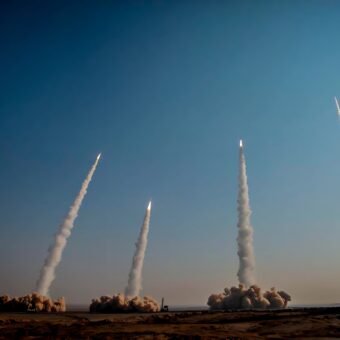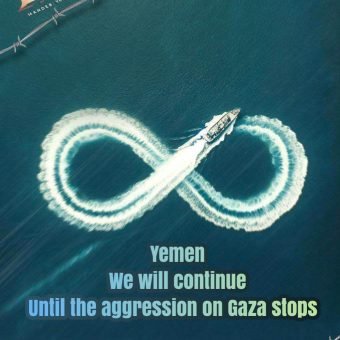Hezbollah’s Deterrence: A Turning Point in the Middle East Conflict
For the first time in modern history, a non-state actor—Hezbollah—has successfully established deterrence over one of the most formidable armies in the world, the Israeli Occupation Forces (IOF), and the most dominant military force in the Middle East. Hezbollah’s capacity to inflict substantial damage on Israel has compelled the latter to recognise its capabilities, leading to a significant shift in the strategic balance of power.
Employing inexpensive rockets and drones, Hezbollah has regained the upper hand and executed a calculated retaliation against Israel, even as US and NATO forces have mobilised in defence of Israel. Despite this, Israeli Prime Minister Benjamin Netanyahu claimed that the IOF had successfully launched a pre-emptive strike against Hezbollah, allegedly preventing the launch of over 1,000 to 6,000 missiles aimed at Tel Aviv. However, no secondary explosions were observed, nor were there any confirmed Hezbollah casualties among the missile launch units or the warehouse guards reportedly targeted and killed in the Israeli strikes.
This article examines how Hezbollah has established deterrence, the lack of credibility of Israel’s claims of pre-emptive action, and the broader implications for the Middle East.
Establishing Deterrence
Hezbollah’s recent actions have marked a significant shift in the region’s power dynamics. By launching 320 rockets and drones across the Lebanese border and targeting areas over 100 kilometres inland, including north of Tel Aviv, Hezbollah demonstrated its military capabilities. These attacks followed the collapse of negotiation talks in Qatar and came during the anticipated resumption of negotiations in Cairo.
Hezbollah’s bombing of strategic Israeli military positions deep inside the country reflected its precise intelligence capabilities and its ability to bypass Israel’s sophisticated missile interception systems. The over 100-kilometre range of the Hezbollah strike mirrored Israel’s violation of the Rule of Engagement, which saw Israel bombing the Beirut suburb of Dahiyeh and assassinating one of Hezbollah’s Jihadi Council commander, Fouad Shukr. Despite Israeli threats, Hezbollah’s retaliatory strikes underscored its readiness to act, establishing a new phase of deterrence.
Netanyahu’s Dubious Claims of Pre-emptive Strikes
Netanyahu’s claim that a pre-emptive strike by the IOF had destroyed Hezbollah’s missile-launching positions and prevented an attack on Tel Aviv has been met with scepticism. According to Netanyahu, the strike supposedly destroyed over 1,000 to 6,000 missiles but failed to cause heavy casualties among Hezbollah’s specialised units. However, Hezbollah’s immediate response, which involved the launching of hundreds of rockets and drones, challenges Israel’s narrative.
If Israel’s pre-emptive strike had indeed neutralised Hezbollah’s missile-launching capabilities, Hezbollah’s retaliatory barrage would have been unlikely. The scale and precision of Hezbollah’s subsequent attacks indicate that Israel’s strike did not achieve the level of success Netanyahu claimed. The long-prepared response shows that Hezbollah’s military infrastructure and operational capacity remain largely intact, directly contradicting Israeli assertions of a crippling blow to Hezbollah’s forces.
Hezbollah’s Arsenal and Tactical Restraint
Israel has long maintained that Hezbollah possesses an extensive missile arsenal, with estimates reaching up to 250,000 missiles, including short, medium, and long-range precision-guided munitions. Given the sheer size of this arsenal, the destruction of 1,000 or even 6,000 missiles would not critically impair Hezbollah’s ability to wage war or retaliate. Large-scale pre-emptive strikes by Israel would be insufficient to disturb Hezbollah’s offensive capabilities comprehensively.
In this fire exchange, Hezbollah refrained from using its medium and long-range precision missiles, reserving them for future engagements. This strategic restraint underscores Hezbollah’s careful management of its arsenal, opting instead to use older and less sophisticated rockets and drones. Even with hundreds of rockets, Hezbollah was able to effectively breach Israeli defences, further illustrating its capacity to mount significant retaliatory strikes without exhausting its more advanced assets.
Tactical Precision and Israel’s Weak Justification
Israel’s pre-emptive strike claims rest on the assumption that neutralising Hezbollah’s missile-launching positions would significantly diminish its threat. However, Hezbollah’s rapid and forceful retaliation undermines this justification. Hezbollah has developed an extensive network of concealed missile depots, underground bunkers, and mobile launchers, making it extremely difficult for Israel or its Western allies to detect and destroy them pre-emptively.
In its retaliation, Hezbollah also effectively utilised drones, demonstrating its operational sophistication. Each drone requires a minimum of three personnel to operate, and launching dozens of drones simultaneously necessitates a large number of militants. Despite Israel and Western reconnaissance efforts, Hezbollah was able to carry out these operations undetected. The drones were likely launched from concealed positions such as caves or underground facilities, making them nearly impossible for Israel to intercept or deter.
Strategic Calculations and the “Axis of Resistance”
Hezbollah’s determined but calculated restraint in withholding its more advanced missiles is a powerful deterrence mechanism. This strategic decision signals to Israel that Hezbollah retains the capacity for a much more devastating response should the conflict escalate further. Hezbollah’s leadership understands the importance of maintaining a credible deterrence posture, ensuring that Israel remains cautious about provoking an all-out war that could severely damage its infrastructure and military assets.
Hezbollah’s response also revealed a crucial aspect of the “Axis of Resistance”—the informal alliance between Iran, Hezbollah, and other regional forces opposed to Israel. Hezbollah’s independent retaliation demonstrated that these groups do not necessarily need to coordinate their strikes to effectively challenge Israel on multiple fronts simultaneously. This independent action by Hezbollah shifted the focus back to the ongoing conflict in Gaza and Palestine, diverting attention from the wider regional tensions that had built up in recent months.
Broader Middle East Implications
Hezbollah’s retaliation not only altered Israel’s strategic calculus but also helped dissipate the regional tension that had been building over recent months. Netanyahu’s escalation against multiple Middle Eastern capitals had brought additional thousands of Western troops into the region, raising the spectre of a broader conflict that the US was keen to avoid.
By executing its planned revenge strike, Hezbollah returned the spotlight to Gaza, undermining Netanyahu’s narrative that he alone could protect Israel from its many enemies.
The US has since sent a message to Lebanon indicating that Israel considers the situation de-escalated, suggesting that the Israeli leadership recognises Hezbollah’s deterrence. Israel’s reluctance to escalate further suggests that Hezbollah’s retaliation has restored the rules of engagement that Israel had violated with its bombing of Beirut. This underscores the profound impact of Hezbollah’s actions on the region’s geopolitical landscape.
Hezbollah’s establishment of deterrence against Israel marks a significant milestone in the ongoing conflict between the two sides. The group’s ability to launch precise strikes deep into Israeli territory has forced Israel to acknowledge Hezbollah’s growing military prowess. Netanyahu’s claims of a successful pre-emptive strike against Hezbollah are fraught with inconsistencies, as demonstrated by Hezbollah’s rapid and effective retaliation.
As Hezbollah continues to gather experience and test Israel’s defences, the balance of power in the region is shifting. Israel remains a formidable military force, but Hezbollah’s growing capabilities suggest that any future conflict will be far more destructive on Israel than previous engagements since 1967. For now, Hezbollah has regained the upper hand, proving that a non-state actor can challenge one of the world’s most powerful militaries and emerge with strategic leverage.
≈≈≈
⭕ My [Magnier’s] view:
#Hezbollah’s retaliation is strategic:
it indicates
- there is no coordinated and joint attack with #Iran, #Yemen and #Iraq to “destroy #Israel”
- There is no need to gather this level of US and NATO forces in the ME.
- Keep and redirect the focus on #Gaza
⭕️ Hezbollah: We launched more than 320 Katyusha rockets at Israeli bases and barracks this morning, in an initial stage of the retaliation
This was the first stage of our attack, which had as its goal to open up the way for our attack drones, which hit their intended targets thanks to God.
We targeted the following sites:
1. ‘Miron’ Air Command & Control Base
2. Nephi Ziv Base
3. Zatoun Base
4. Zaoura’s Barracks
5. Al-Sahl Base
6. Keila Barracks in the occupied Syrian Golan
7. Yoav Barracks in the occupied Syrian Golan
8. Nafah base in the occupied Syrian Golan
9. Yardin base in the occupied Syrian Golan
10. Ain Zay Taym base
11. Ramot Naftali Barracks












He fleshes out his thoughts in this video, further debunking the lies.
Conventionally, both the West and Zion, like 404, are hamstrung and at total mercy of ongoing attrition war. Only vertical escalations remain…
https://youtu.be/p2NZKdaMG6o
I’m reading my way through today’s postings in the Salon (Apocalypse thread), filled with much detail about the Hezbollah strike and the reaction (NOT pre-emption) from Israel, which now considers the “case closed” – per Magnier. Once again I am astonished by the strategic skill with which the resistance slices… Read more »
Dear Grieved: I have needed time to respond to your comment. Because the rich depth of understated wisdom you have imparted has cut me open. Obliging me to face, once again, how deeply our global political struggle is a seemingly perfect match for my own internal self struggle. Your comment reminds me… Read more »
Is that not the basis of the thinking in the alchemical Emerald Tablet, the Smaragdine Table, or the Tabula Smaragdina. We know the quote and ascribe it to Hermes Trismegistus. But it actually is from a number of very early medieval Arabic sources As above, so below – that is… Read more »
The understanding of “As above so below” is from long ages before the medieval and even long before the high culture of the Persians who before Islam were Zoroastrian, and before the Ancient Greeks too. Probably the concept is originally from any one of the ancient civilisations who practised Astrology,… Read more »
You know, Snow Leopard, if I may offer, the teachings of Buddhism would give you a flawless and perfect framework in which to establish your struggle. It’s the struggle of all sentience, but the Buddha found and taught a path that cuts through it, the path that transcends the suffering… Read more »
Yes and thank you to both Grieved and Amarynth. Grieved I did not fail to notice that your original comment revealed the quality of your grounding in Buddhism. You touched my heart with that information about the mythic symbolism of the Snow Leopard. I found myself emulating the Saker in… Read more »
Wonderful perception Grieved, I totally concur, thank you 🙂
Btw, Al-Qassam Brigades announced shelling Tel Aviv with a M90 rocket. Iron Dome failed.
‘deterrence’ in lower case, I suggest. Today, pre-dawn, Lebanon got hit in 40 bases, depots, weapons sites by 100 IDF jet fighters. Nothing deterred. The Zionists own the skies and fly day or night, dusk or dawn. The reality is stark. Hezbollah can and does hurt IDF and settler regions.… Read more »
Larch, they also claimed to have shot down 6,000 missiles enroute to Tel Aviv. It’s all lies. There were no secondary explosions nor claimed martyrs, so they didn’t strike depots or troop gatherings. In fact Nasrallah broke it down in latest speech. They bombed empty valleys and claimed victory, the… Read more »
Yep. As Nasrallah said (in the Global South paraphrased summary elsewhere):
First, Netanyahu lies. His eyes rolled around in his head this morning with his speech so that it looked like he had participated in Zelenski’s white stash. 100? What is destroyed? Some more civilians? Not even. Hezbollah is as strong as always and this is but their initial phase. We are waiting… Read more »
💠 @ejmalrai:
⭕ No Israeli settler will return to the north, the Lebanese borders, if the war on #Gaza continues. That is another #Hezbollah’s deterrence.